 W
WAdoration of the Magi is a 1650s religious painting by the Italian Baroque artist from Genoa, Bartolomeo Biscaino. It is now in the Musée des Beaux-Arts of Strasbourg, France, for which it was bought in 1878, shortly after the city had decided to rebuild its collections, which had been completely destroyed on 24 August 1870, in the fire of the Aubette during the Siege of Strasbourg. Accordingly, the painting's inventory number is 1.
 W
WAdoration of the Magi is a circa 1650 religious painting by the Italian Baroque artist from Genoa, Valerio Castello. It is now in the Musée des Beaux-Arts of Strasbourg, France. Its inventory number is 1830.
 W
WAir is a painting created by Flemish painter Jan van Kessel (1626–1679) and was painted around the year 1647. It is a part of the permanent collection at the Flint Institute of Arts.
 W
WThe Allegory of Divine Providence and Barberini Power is a fresco by Italian painter Pietro da Cortona, filling the large ceiling of the grand salon of the Palazzo Barberini in Rome, Italy. Begun in 1633, it was nearly finished in three years; upon Cortona's return from Venice, it was extensively reworked to completion in 1639. The Palazzo, since the 1620s, had been the palatial home of the Barberini family headed by Maffeo Barberini, by then Urban VIII, who had launched an extensive program of refurbishment of the city with art and architecture.
 W
WAnanias Curing Saul's Blindness is a 1660 painting by Ciro Ferri, now in the Kunsthistorisches Museum in Vienna. It shows Ananias' visiting Paul of Tarsus to cure his temporary blindness.
 W
WApollo as Victor over Pan, also known as Apollo's Victory over Marsyas, Tmolus declaring Apollo winner in musical competition with Pan and Apollo and Pan, is a 1637 oil-on-canvas painting by Flemish Baroque painter, draughtsman and tapestry designer Jacob Jordaens.
 W
WThe Apotheosis of Palermo is a fresco by Vito D'Anna in the Palazzo Isnello, Palermo, Italy, considered one of the most representative works of the Sicilian Baroque painting.
 W
WApotheosis of Saint Sebastian is a circa 1725 oil on canvas painting by the Italian Baroque painter Sebastiano Ricci. It is now in the Musée des Beaux-Arts of Strasbourg, France. Its inventory number is 994-1-5.
 W
WThe Arrival of Marie de Medici at Marseilles is a c. 1622-1625 Baroque painting done by Sir Peter Paul Rubens. It was commissioned by Marie de' Medici of France to commemorate the life of her and her husband Henry IV of France. This painting was one of the 24 paintings in the Marie de' Medici cycle by Rubens. The painting currently resides in the Louvre in Paris.
 W
WThe Capel Family is one of the few group portraits by Cornelius Johnson, who is better known for head and shoulders portraits.
 W
WCyparissus is a 1620s Baroque painting on a mythological subject from Ovid's Metamorphoses by the Italian painter Jacopo Vignali. It is on display in the Musée des Beaux-Arts of Strasbourg, France, to which it had been donated by the collectors Othon Kaufmann and François Schlageter in 1994. Its inventory number is 994-1-8, or 44.994.1.8.
 W
WThe Four Seasons is a cycle of four frescoes by Francesco Sozzi in the Palazzo Isnello, Palermo, Italy.
 W
WGlasses in a Basket is a 1644 Baroque still life painting by the Alsatian artist Sebastian Stoskopff. It is on display in the Musée de l'Œuvre Notre-Dame of Strasbourg, France. Its inventory number is MBA 1281.
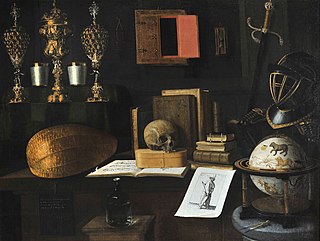 W
WThe Great Vanity is a 1641 Baroque allegorical still life painting by the Alsatian artist Sebastian Stoskopff. It is on display in the Musée de l'Œuvre Notre-Dame. Its inventory number is MBA 1249.
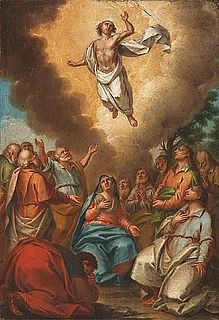 W
WThe Heptanese School of painting succeeded the Cretan School as the leading school of Greek post-Byzantine painting after Crete fell to the Ottomans in 1669. Like the Cretan school it combined Byzantine traditions with an increasing Western European artistic influence, and also saw the first significant depiction of secular subjects. The school was based in the Ionian Islands, which were not part of Ottoman Greece, from the middle of the 17th century until the middle of the 19th century.
 W
WIngenuity is an allegorical Baroque painting by the Bolognese painter Giuseppe Maria Crespi. The painting is also known as Amor Victorious. It is on display in the Musée des Beaux-Arts of Strasbourg, France, to which it had been donated by the collectors Othon Kaufmann and François Schlageter. Its inventory number is 994-1-1, or 44.994.1.1.
 W
WInmaculada Concepción is a painting made by Bartolomé Esteban Murillo in the year 1670. It belongs to the collection of Museo Soumaya, Fundacion Carlos Slim. The technique is oil on canvas, and its dimensions are 168 x 112 cm.
 W
WJoseph's Dream is a 1620s painting by Daniele Crespi, now in the Kunsthistorisches Museum in Vienna. It shows an angel appearing to Joseph of Nazareth in his sleep to warn him of Herod the Great's intent to kill Jesus and to instruct him to flee into Egypt, the second of Saint Joseph's dreams in the Gospel of Matthew.
 W
WLandscape with Tobias and the Angel is a large Baroque landscape painting by the Southern Italian painter Salvator Rosa. It includes a Christian theme from the Book of Tobit: Tobias and the archangel Raphael with the fish from the river Tigris. The painting is on display in the Musée des Beaux-Arts of Strasbourg, France. Its inventory number is 182.
 W
WThe Lute Player is a painting from c. 1612–1615 by the Italian artist Orazio Gentileschi (1563–1639) depicting a young woman in a golden dress with a lute.
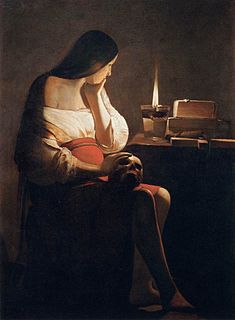 W
WMagdalene with the Smoking Flame is a c. 1640 oil-on-canvas depiction of Mary Magdalene by French Baroque painter Georges de La Tour. Two versions of this painting exist, one in the Los Angeles County Museum of Art and the other in the Louvre Museum.
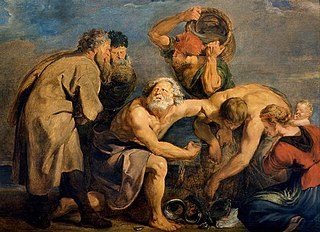 W
WThe Miraculous Draught of Fishes is a circa 1618–1620 oil painting depicting a New Testament episode, by the Flemish artist Jacob Jordaens. It is on display in the Musée des Beaux-Arts of Strasbourg, France. Its inventory number is 618.
 W
WThe Portrait of the Gem-cutter Dionysio Miseroni and his Family is a 1653 group portrait by Czech artist Karel Škréta of an craftsman's family. This representative example of the Bohemian Baroque style is currently deposited in the Schwarzenberg Palace, a part of collection of the National Gallery in Prague, Czech Republic.
 W
WMusicians and Soldiers is a circa 1626 painting by the French Caravaggisto Valentin de Boulogne. It is now in the Musée des Beaux-Arts of Strasbourg, France. Its inventory number is 1280.
 W
WPallas and Arachne, also known as Minerva Punishing Arachne and occasionally referred to as Arachne Punished by Pallas, is an oil-on-board painting by Flemish artist Peter Paul Rubens completed in 1636 or 1637.
 W
WPortrait of Cardinal Richelieu is a portrait painting by the Flemish-born French painter Philippe de Champaigne, Richelieu's favourite portraitist. It was painted a few months before the cardinal's death and is now in the Musée des Beaux-Arts of Strasbourg, France. Its inventory number is 987–2–1.
 W
WThe Recovery of Bahía de Todos los Santos is a mature work by the Spanish painter Juan Bautista Maíno (1580–1649). It was painted between 1634 and 1635 and commemorates the recapture of the Brazilian port of Salvador da Bahia from the Dutch by Fadrique Álvarez de Toledo y Mendoza in May 1625 and its return to the Portuguese Empire. Originally in the Salón de Reinos for which it was painted, it is now in the Prado Museum.
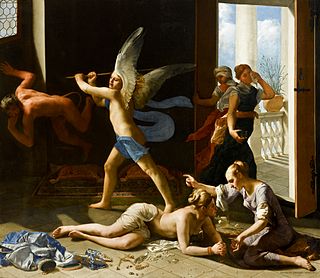 W
WThe Repentant Magdalene is an oil painting of the early 1660s by the Baroque Italian painter Guido Cagnacci. It shows Mary Magdalene, beside her remonstrating sister Martha, at the moment she repents, echoed by an allegorical pairing of Virtue, an angel, chasing out Vice, a devil. The painting forms part of the collection of the Norton Simon Museum.
 W
WThe Resurrection by Cecco del Caravaggio, the Italian Baroque painter, is the only painting known for certain to be his. It was commissioned in 1619 by Piero Guicciardini, the Tuscan ambassador to Rome. Through the use of alternate strong lights and deep shadows the chiaroscuro highlights the vividness of the dramatic scene. One of Cecco's most notable works, the painting is in the permanent collection of the Art Institute of Chicago.
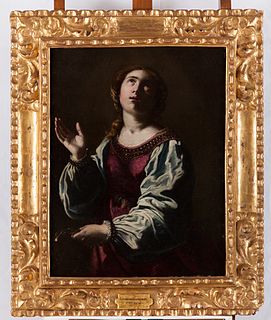 W
WSaint Apollonia is a painting attributed to the Italian baroque painter Artemisia Gentileschi executed between 1642 and 1644. It is part of the collection of the Museo Soumaya in Mexico City, Mexico.
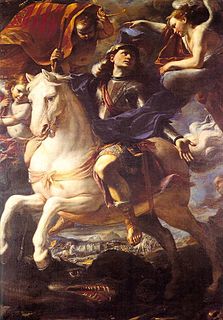 W
WSaint George on Horseback is an oil painting by Mattia Preti painted in 1658. It is the altarpiece of the Chapel of the Langue of Aragon in St. John's Co-Cathedral, Valletta, Malta. The painting was Preti's first work in Malta, and it is regarded as one of his masterpieces and one of the best examples of Neapolitan Baroque art.
 W
WSaint Sebastian and the Angel is a late 1620s painting by the Italian artist from Ferrara, Carlo Bononi. The work is now in the Musée des Beaux-Arts of Strasbourg, France.
 W
WSt John the Baptist Wearing the Red Tabard of the Order of St John is a painting by Mattia Preti, from 1671.
 W
WSaint Anthony of Padua holding the Infant Jesus is a devotional painting by the Italian artist from Genoa, Bernardo Strozzi. It is stylistically dated from his middle period and was made around 1625 in his hometown. The painting was presented to the Musée des Beaux-Arts of Strasbourg, France, by the collectors Othon Kaufmann and François Schlageter in 1994. Its inventory number is 44.994.1.7.
 W
WA Waterfall in a Rocky Landscape is an oil painting on canvas by the Dutch landscape painter Jacob van Ruisdael. It is an example of Dutch Golden Age painting and is now in the collection of the National Gallery.
 W
WWomen Gladiators is a painting by Jusepe de Ribera made in oil on canvas. It is conserved in the Museo del Prado, Madrid.